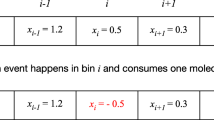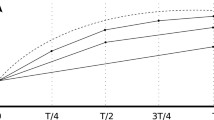Abstract
Noise in cellular systems is often modeled and simulated with Gillespie’s stochastic simulation algorithm (SSA), but the low efficiency of the SSA limits its application to large biochemical networks. To improve the efficiency of stochastic simulations, Haseltine and Rawlings (HR) proposed a hybrid algorithm, which combines ordinary differential equations for traditional deterministic models and the SSA for stochastic models. In this paper, accuracy of the HR hybrid method is studied based on a linear chain reaction system. Mathematical analysis and numerical results both show that the HR hybrid method is accurate if either the quantity of reactant molecules in fast reactions is above a certain threshold, or the reaction rates of fast reactions are much larger than those of slow reactions. This analysis also shows that the HR hybrid method approximates the chemical master equation well for a much greater region in system parameter space than the slow-scale SSA and the stochastic quasi-steady-state assumption methods.












Similar content being viewed by others
References
Anderson DF (2007) A modified next reaction method for simulating chemical systems with time dependent propensities and delays. J Chem Phys 127(214):107
Anderson DF (2008) Incorporating postleap checks in tau-leaping. J Chem Phys 128(054):103
Anderson DF, Ganguly A, Kurtz TG (2011) Error analysis of tau-leap simulation methods. Ann Appl Probab 21:2226–2262
Barik D, Ball DA, Peccoud J, Tyson JJ (2016) A stochastic model of the yeast cell cycle reveals roles for feedback regulation in limiting cellular variability. PLoS Comput Biol 12(12):1–36
Cao Y, Gillespie DT, Petzold LR (2005a) Avoiding negative populations in explicit poisson tau-leaping. J Chem Phys 123(5):054104
Cao Y, Gillespie DT, Petzold LR (2005b) The slow-scale stochastic simulation algorithm. J Chem Phys 122(1):14116
Chen KC, Calzone L, Csikasz-Nagy A, Cross FR, Novak B, Tyson JJ (2004) Integrative analysis of cell cycle control in budding yeast. Mol Biol Cell 15:3841–3862
Chiam KH, Tan CM, Bhargava V, Rajagopal G (2006) Hybrid simulations of stochastic reaction–diffusion processes for modeling intracellular signaling pathways. Phys Rev E 74(051):910
Davis MHA (1984) Piecewise-deterministic markov processes: a general class of non-diffusion stochastic models. J R Stat Soc Ser B (Methodol) 46(3):353–388
Franz U, Liebscher V, Zeiser S (2012) Piecewise-deterministic markov processes as limits of Markov jump processes. Adv Appl Probab 44(3):729–748
Gillespie DT (1992) A rigorous derivation of the chemical master equation. Physica A Stat Mech Appl 188:404–425
Gillespie DT (2001) Approximate accelerated stochastic simulation of chemically reacting systems. J Chem Phys 115:1716
Haseltine EL, Rawlings JB (2002) Approximate simulation of coupled fast and slow reactions for stochastic chemical kinetics. J Chem Phys 117(15):6959–6969
Hoops S, Sahle S, Gauges R, Lee C, Pahle J, Simus N, Singhal M, Xu L, Mendes P, Kummer U (2006) COPASI—a complex pathway simulator. Bioinformatics 22:3067–3074
Jahnke T, Kreim M (2012) Error bound for piecewise deterministic processes modeling stochastic reaction systems. Multiscale Model Simul 10(4):1119–1147
Kang HW, KhudaBukhsh WR, Koeppl H, Rempała GA (2017) Quasi-steady-state approximations derived from the stochastic model of enzyme kinetics. q-bio. https://arxiv.org/abs/1711.02791. Accessed 10 Jan 2018
Kar S, Baumann WT, Paul MR, Tyson JJ (2009) Exploring the roles of noise in the eukaryotic cell cycle. PNAS 106(16):6471–6476
Kim JK, Sontag ED (2017) Reduction of multiscale stochastic biochemical reaction networks using exact moment derivation. PLoS Comput Biol 13(6):1–24
Kloeden PE, Platen E (1992) Numerical solution of stochastic differential equations. Applications of mathematics (New York), vol 23. Springer, Berlin
Lecca P, Bagagiolo F, Scarpa M (2017) Hybrid deterministic/stochastic simulation of complex biochemical systems. Mol BioSyst 13:2672–2686
Liu Z, Pu Y, Li F, Shaffer CA, Hoops S, Tyson JJ, Cao Y (2012) Hybrid modeling and simulation of stochastic effects on progression through the eukaryotic cell cycle. J Chem Phys 136(3):034105
Lo WC, Zheng L, Nie Q (2016) A hybrid continuous-discrete method for stochastic reaction–diffusion processes. Open Sci 3(9):160485
McQuarrie DA (1967) Stochastic approach to chemical kinetics. J Appl Probab 4:413–478
Petzold LR (1982) A description of DASSL: a differential/algebraic system solver. In: The IMACS World Congress, vol 1, p 65
Qu Z, Weiss JN, MacLellan WR (2003) Regulation of the mammalian cell cycle: a model of the G1-to-S transition. Am J Physiol Cell Physiol 284(2):C349–C364
Rao CV, Arkin AP (2003) Stochastic chemical kinetics and the quasi steady-state assumption. J Chem Phys 118(11):4999–5010
Rossinelli D, Bayati B, Koumoutsakos P (2008) Accelerated stochastic and hybrid methods for spatial simulations of reaction–diffusion systems. Chem Phys Lett 451(1):136–140
Salis H, Kaznessis Y (2005) Accurate hybrid stochastic simulation of a system of coupled chemical or biochemical reactions. J Chem Phys 122(5):054103
Salis H, Sotiropoulos V, Kaznessis YN (2006) Multiscale Hy3S: hybrid stochastic simulation for supercomputers. BMC Bioinform 7(1):93
Tyson JJ (1991) Modeling the cell division cycle: Cdc2 and cyclin interactions. PNAS 88(16):7328–7332
Tyson JJ, Novak B (2008) Temporal organization of the cell cycle. Curr Biol 18(17):R759–R768
Wang S, Cao Y (2015) The abridgement and relaxation time for a linear multi-scale model based on multiple site phosphorylation. PLoS ONE 10(8):e0133295
Wang S, Ahmadian M, Chen M, Tyson JJ, Cao Y (2016) A hybrid stochastic model of the budding yeast cell cycle control mechanism. In: The 9th ACM conference on bioinformatics, computational biology, and health informatics, pp 261–270
Wang S, Chen M, Watson LT, Cao Y (2017) Efficient implementation of the hybrid method for stochastic simulation of biochemical systems. J Micromech Mol Phys 02(02):1750006
Wilkinson JH (1965) The algebraic eigenvalue problem. Oxford University Press, Oxford
Winkelmann S, Schtte C (2017) Hybrid models for chemical reaction networks: multiscale theory and application to gene regulatory systems. J Chem Phys 147(11):114115
Acknowledgements
This work was supported by the National Science Foundation under Award MCB-1613741 and CCF-1526666.
Author information
Authors and Affiliations
Corresponding author
Appendices
Appendix A: Solution of NSRFT for the Simple Case (\(n=2\))
1.1 A.1: Solution to CME
Matrix A for the simple system (24) is
A has two eigenvalues
Let \(\mathbb {P}(0)=(1\),\(0)^T\). The solution is given by
Let \({\mathbb {P}}(0)=(0\),\(1)^T\). The solution is then
Define \(q_{1}(t,k_c)\) and \(q_{2}(t,k_c)\) as
According to Eq. (14), \(T_c\) satisfies
1.2 A.2: Solution to the HR Hybrid Method
The ODE system for the fast subsystem is
with
Given the initial condition \((x_1(0)\), \(x_2(0))^T=(m_1\),\(m_2)^T\), the solution is
\(T_h\) satisfies the equation
1.3 A.3: Solutions to ssSSA and SQSSA
By applying the ssSSA, the fast subsystem is assumed to stay at steady state without the impact of \(k_c\), which is \(x_1^*=x_2^*=m/2\). Thus, \(f_w=1/2\) and \(T_w\) satisfies the equation
In contrast, under the SQSSA assumption, only species \({S}_2\) stays at steady state. \(x_2(t)\) satisfies
and the solution is \(x_2(t)= m/(2+k_c)\). So \(f_q(k_c)=1/(2+k_c)\) and \(T_q\) as a result satisfies
Appendix B: Accuracy Analysis of General Cases
In Sect. 4.2, the accuracy analysis is applied to a general linear model with \({S}_n\) as the exit state. For a model with \({S}_v\) (\(1\le v \le n\)) as the exit state, we have a similar analysis process for the HR hybrid method.
Consider a general linear model

For the HR hybrid method, the linear chain reactions are taken as the fast subsystem and the irreversible reaction is the slow subsystem. The HR hybrid method shares the same matrix \(\tilde{A}\) in Eq. (15) regardless of the value of v. Factor v only affects the computation of \(T_h\). \(T_h\) is implicitly given by
Comparing with Eq. (17), we find \(\mathbf {e}^T_n\) is replaced with \(\mathbf {e}^T_v\) in Eq. (33).
As to the CME for this general system, a new matrix \(E_v\) is introduced. \(E_v\) has an element \(E_{v}(v,v)\) equal to \(k_c\) and all the others equal to 0. Matrix \(A_v\) is constructed as
Following the same derivation in Sect. 3.1, we have
In Sect. 4.2, the effects of parameter \(k_c\), population m as well as the length of chain n on accuracy have been discussed. Here, we will show how the parameter v impacts the accuracy.
Consider a general chain reaction system of length n. Reaction rates satisfy \(f_i=b_i\) for \(1\le i\le n-1\). At the initial time, the probability that one particle stays in state \({S}_i\) is 1 / n. To trigger a slow reaction event, a particle must reach state \({S}_v\) first. The length one particle jumps from \({S}_i\) to \({S}_v\) is defined by \(|i-v|\). The average jumping length is computed as
We can verify that when \(v=1\) or \(v=n\), \(d_v\) reaches its maximum value \((n-1)/2\). When \(v=\lceil n/2\rceil \), the minimum value of \(d_v\) is about n / 4, half the value of the maximum one. From intuition, \(d_v\) can be regarded as a measurement of the average next slow reaction time T. The larger the value of \(d_v\) is, the longer time one particle may spend to reach the exit state \({S}_v\).
On the other hand, we have defined two functions \(f^{(v)}_{h}(t)\) and \(f^{(v)}_{c}(t,k_c)\) in Eqs. (33) and (34), respectively. These two functions have the same properties as their counterparts in Sect. 4.2. We illustrate that the error of the HR hybrid method decreases as \(T_c\) and \(T_h\) move toward 0 from the analysis in Sect. 4.2, Thus the smaller \(d_v\) is, the more accurate the HR hybrid method will be.
We set \(n=10\) and vary v from 6 to 10. Average relative errors \(|T_c-T_h|/T_c\) were calculated with different m and \(k_c\). Values of m and \(k_c\) which lead to the relative error of 0.01 are listed in Table 3. From the results, we can see parameter v has a crucial impact on the threshold of \(k_c\). The value of \(k_c\) with respect to \(v=6\) is almost four times larger than the one with respect to \(v=10\). Whereas, when reducing v from 10 to 6, the threshold of m only decreases by 10%.
Appendix C: Calculation of \(\beta _1\)
The value of \(\beta _1\) in Sect. 4.3 is calculated below. For \(\tilde{\lambda }_1=0\), its left eigenvector is \(\mathbf {e}\). Its right eigenvector \({\varvec{\eta }}_1\) is
There is a symmetric tridiagonal matrix \(\tilde{A}_\mathrm{s}\) similar to \(\tilde{A}\), given by
where D is a diagonal matrix that
Since \(\tilde{A}_\mathrm{s}\) is symmetric, there is a unitary matrix \(Q=[\mathbf {q}_1,\mathbf {q}_2,\ldots ,\mathbf {q}_n]\), where \(\mathbf {q}_i\) are eigenvectors of \({\tilde{A}}_\mathrm{s}\). Q satisfies
where \({\tilde{\varLambda }} = \text {diag}(0,{\tilde{\lambda }}_2,\ldots ,{\tilde{\lambda }}_{n})\). Let \(P=[{\varvec{\eta }}_1,\mathbf {\eta }_2,\ldots ,{\varvec{\eta }}_n]\) and we have
As a consequence, \({\varvec{\eta }}_i = a_iD\mathbf {q}_i\), where \(a_i\) is a real number. By applying the property \(\mathbf {q}_i^T\mathbf {q}_i=1\), \(a_i\) is computed as
On the other hand, \(e^{-\tilde{A}t}\) can be written as
So we get
Appendix D: Formulation of Bistable Switch Model
Section 5.1 studied the bistable switch model as a system (26). In this appendix, we will now show how multiple linear chain systems like (32) can formulate system (26). In system (26), proteins \(\text {Cdh1P}_i\) (\(i=0,1,\dots ,9\)), form a linear chain which is the fast subsystem. At the same time, each \(\text {Cdh1P}_i\) acts as an enzyme activating the Clb2 degradation reaction. Notice that the synthesis and degradation of Clb2 are taken as slow reactions. Between two consecutive slow reactions, the population of Clb2 does not change. By ignoring the synthesis and degradation of Clb2, for each \(\text {Cdh1P}_i\) we have an equivalent system which reads as

where the slow reaction is the irreversible reaction which consumes a \(\text {Cdh1P}_i\) and generates a \(\text {Cdh1P}_i\). Clb2 in this reaction is considered as part of the slow reaction rate. Therefore, system (35) is exactly a concrete instance of system (32).
Rights and permissions
About this article
Cite this article
Chen, M., Wang, S. & Cao, Y. Accuracy Analysis of Hybrid Stochastic Simulation Algorithm on Linear Chain Reaction Systems. Bull Math Biol 81, 3024–3052 (2019). https://doi.org/10.1007/s11538-018-0461-z
Received:
Accepted:
Published:
Issue Date:
DOI: https://doi.org/10.1007/s11538-018-0461-z




